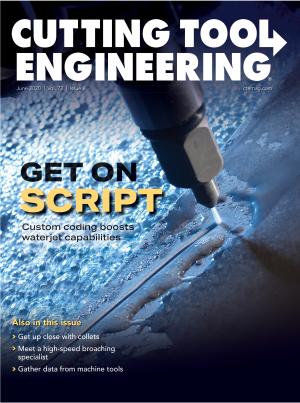Experts, scholars and industrial leaders agree that we have entered the Fourth Industrial Revolution, which is characterized by interconnectedness of devices and the ability to collect seemingly unlimited amounts of data for analysis.
“Internet of things” is jargon that has emerged since the onset of the Fourth Industrial Revolution. IoT is driving new technologies, making connections and communication between devices commonplace in industrial settings. Companies now have access to a volume and quality of data that were not available in the past. As machine tools advance, controls will be able to provide not only a stream of data but the software and apps needed to analyze the data stream.
Our society craves data, which has become an integral part of the modern economy. It is therefore easy to see why manufacturers want data from many sources, including machine tools. Six Sigma, statistical process control and other lean manufacturing concepts rely on a good flow of data to drive improvements, and advances in connectivity thanks to new technologies make it simple for businesses to get data they never had before.
Helpful Data
High-volume manufacturers often survive on lower margins, so minimizing downtime is critical to profitability. A stream of data helps in a few ways. Being connected to a machine tool allows real-time monitoring, and current software lets a person assess machine condition from anywhere. Consider a shop like ours where one worker tends to several machines. Each of our EDMs is dedicated to a specific operation. If one stopped, it would disrupt the entire machining line. Remaining connected to every machine enables us to monitor machine status from a single location. We immediately know when a machine stops, and it can be addressed right away, reducing lost time.

Machines go down for many reasons, whether because of machining processes or mechanical or electrical failures. In all cases, it is necessary to understand when, why and how frequently a machine tool is out of service so corrective actions can be implemented. Systemic issues may not be recognized without a useful data stream. Collecting, sorting and charting data from machine tools lets us see patterns and trends. Finding those allows a maintenance department to predict failures and plan maintenance instead of reacting to failures, which is the main tenet of total productive maintenance.
Aiding Engineers
Noticing trends also enables manufacturing engineers to find process failures that might not be evident otherwise. Documenting and analyzing trends provided by a good flow of data helps engineers better predict the life of critical wear items, such as cutting tools. Analyzing tool wear and quality data allows engineers to reduce variation in a process, improve quality and lower costs.
Data from machines while in operation makes it possible for manufacturing engineers to investigate machine tool condition at specific times and analyze things like power consumption of various motors and drives. Understanding how much power a machine uses gives insight into the efficiency of machining processes. Drives and motors operating near or at full power can indicate that a machine is being used at maximum capacity or that a machining process is not optimized. High power consumption also may signify imminent mechanical failure.
More advanced data solutions allow engineers to connect temperature sensors, accelerometers, strain gauges and other instruments to machine tools. These devices let engineers study the relationship between a machining process and a machine tool structure. Temperature changes in the structure of a machine tool and miniscule movements among machine tool components indicate process severity and machine rigidity.
When we can see how a machine tool reacts during a cut, it is possible for manufacturing engineers to develop methods that put less stress on a system, which improves tool life and part geometry. Machine tool builders use this same data to build more robust components and structures, improving machine tool efficiency and longevity.
Adaptive machine tool control is the most advanced form of data collection and analysis available for machine tools. Adaptive control takes data from various sensors and adjusts cutting parameters in real time to maintain ideal cutting conditions. Adaptive controls overcome chatter, maintain part size by adjusting for temperature changes and detect worn tools.
Data from machine tools already helps build better machines, develop more robust processes and eliminate inefficiencies. At present, IoT delivers cutting tools that can be adjusted via smartphones. In the future, we will see cutting tools tuned for specific machine tool brands. Connectivity will continue to increase across industry, and larger volumes of data will become available, resulting in a growing rate of technological advancement.
Related Glossary Terms
- chatter
chatter
Condition of vibration involving the machine, workpiece and cutting tool. Once this condition arises, it is often self-sustaining until the problem is corrected. Chatter can be identified when lines or grooves appear at regular intervals in the workpiece. These lines or grooves are caused by the teeth of the cutter as they vibrate in and out of the workpiece and their spacing depends on the frequency of vibration.
- lean manufacturing
lean manufacturing
Companywide culture of continuous improvement, waste reduction and minimal inventory as practiced by individuals in every aspect of the business.
- process control
process control
Method of monitoring a process. Relates to electronic hardware and instrumentation used in automated process control. See in-process gaging, inspection; SPC, statistical process control.
- statistical process control ( SPC)
statistical process control ( SPC)
Statistical techniques to measure and analyze the extent to which a process deviates from a set standard.


